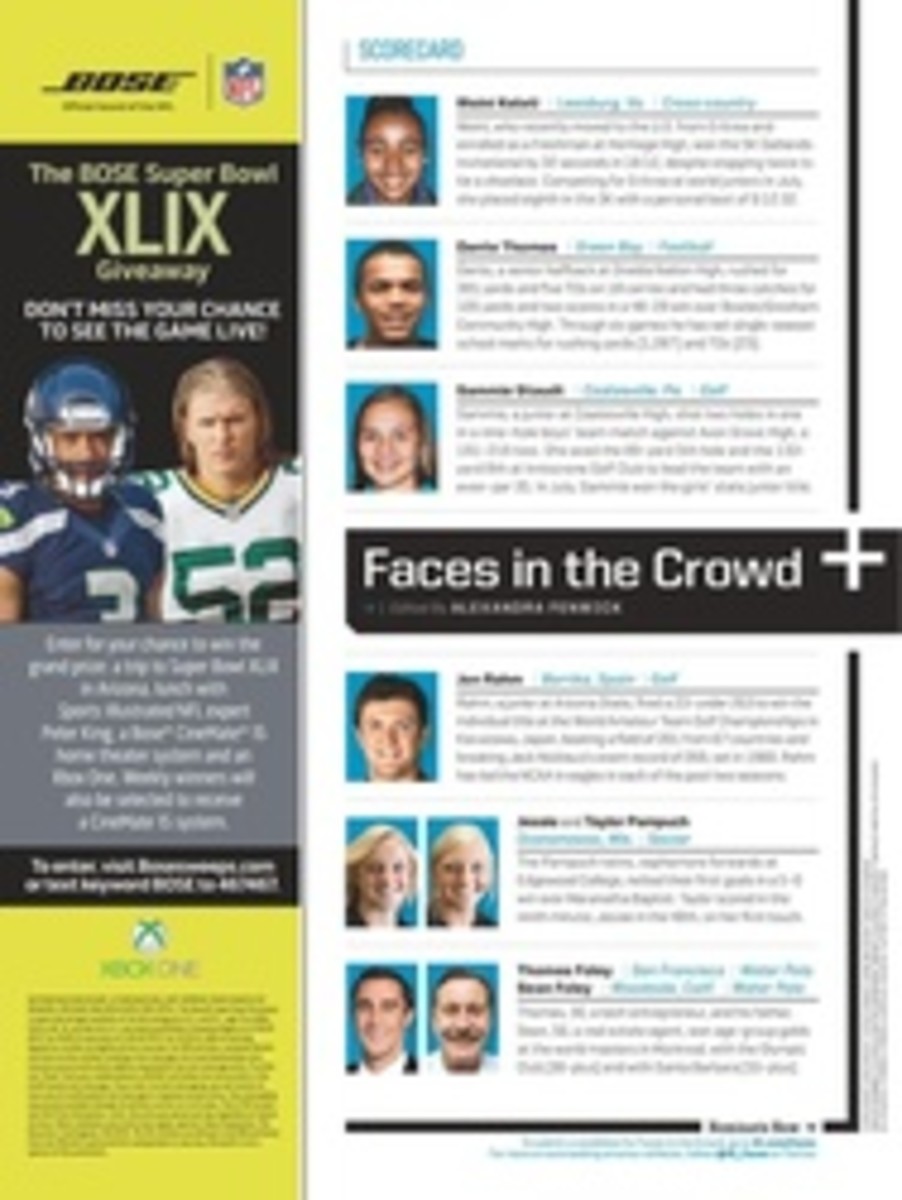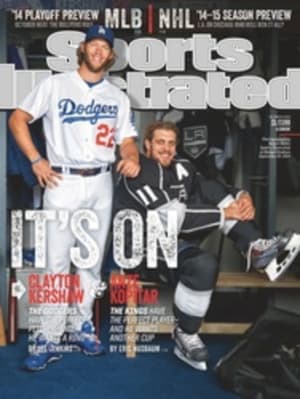
WEST POWER RANKINGS
THE PICK
Stan Bowman went straight to work after the BLACKHAWKS lost in overtime to the Kings in Game 7 of last spring's Western Conference finals. In July the Chicago GM signed captain Jonathan Toews and winger Patrick Kane to matching eight-year, $84 million extensions, thereby negating any chance that contract talks for the two stars would become a distraction this season. Bowman also made an upgrade at a key spot when he signed second-line center Brad Richards to a one-year deal to replace Michal Handzus, who scored just four goals last year. The Rangers castoff may not be the player he was when he led the Lightning to the Stanley Cup in 2004—he's certainly not as fast—but Richards is still productive enough (51 points in 2013--14) to be a key contributor on a championship-caliber team. Witness his performance during New York's run through the playoffs last season, when he scored five goals, including two game-winners.
The Blackhawks, unlike the Rangers, have enough offensive depth to take the heat off Richards. Beyond Kane and Toews, Chicago can lean on leading scorer Patrick Sharp and Marian Hossa, who combined to score 64 goals last season. Third-year winger Brandon Saad has developed into a solid two-way forward. The blue line, led by two-time Norris Trophy winner Duncan Keith, is also intact.
As if that weren't enough, Chicago has a cache of prospects ready to make the jump to the big time, including center Teuvo Teravainen. This is the NHL's model franchise, one with all the necessary parts to win its third Cup in six seasons.
ON THE DOORSTEP
The KINGS are best positioned to thwart the Blackhawks. Like Chicago, L.A. has had a wealth of success and roster stability. GM Dean Lombardi re-signed trade-deadline pickup Marian Gaborik in June. He and linemate Anze Kopitar will boost the Kings' regular-season scoring, which ranked 26th last year. (It's the one area where the team is clearly inferior to the Blackhawks.) A premier defense, led by Drew Doughty, and solid goaltending from Jonathan Quick will keep Los Angeles in the hunt for a second straight Cup.
With the league's most potent offense (3.21 goals per game), the DUCKS shored up their defensive game in June by acquiring two-way center Ryan Kesler from the Canucks. The 30-year-old former Selke Trophy winner can score 20-plus goals while helping Anaheim in the face-off circles—the Ducks ranked 20th in the NHL last year on the dot. But the most pressing question will be in net. Frederik Andersen (.923 save percentage and 2.29 goals-against average in 28 games) was serviceable last year while backing up the now departed Jonas Hiller, but all eyes will be on rookie John Gibson, a second-rounder in 2011 who will make the full-time jump to the big leagues this season.
After their second straight first-round playoff exit, the BLUES made a splash in free agency by signing Avalanche center Paul Stastny (25 goals, 35 assists) to a four-year, $28 million contract. He gives depth to an offense that took a big step forward, averaging 2.91 goals per game, up from 2.58 in 2012--13. Alexander Steen, who scored 33 goals last season should build on a career year alongside center David Backes and T.J. Oshie. On the back end, St. Louis needs Brian Elliott to prove he's still a No. 1 goalie.
ONE PLAYER AWAY
The postmortem analysis on the AVALANCHE was that the team's youth and inexperience doomed it in the postseason. But losing a skintight seven-game series to the Wild, with four games decided in OT, doesn't really make that case. The kids were alright. Colorado lost some good young players over the summer, including 28-year-old center Paul Stastny, but also added experience, acquiring a trio of 30-something vets—forwards Daniel Bri√®re and Jarome Iginla, and defenseman Brad Stuart—who have played a combined 47 NHL seasons and 347 playoff games. They will mentor a talented young group that includes forwards Matt Duchene, Gabriel Landeskog and Nathan MacKinnon, as well as defenseman Erik Johnson.
The STARS made the playoffs for the first time in six years thanks largely to forwards Tyler Seguin (37 goals) and Jamie Benn (34), who scored 31% of the team's goals. The drop-off from there was dramatic—winger Ryan Garbutt was third, with 17 goals. GM Jim Nill traded for the Senators' Jason Spezza (23 goals) on July 1, and signed Spezza's Ottawa teammate Ales Hemsky (13) on the same day. But Dallas's defense has too many holes for the Stars to take the next postseason step.
The WILD signed peripatetic left wing Thomas Vanek in July to a three-year, $19.5 million deal. The two-time 40-goal scorer will most likely play alongside center Mikael Granlund, who should improve on an impressive sophomore year. Minnesota's strength, however, is on the blue line. Last season, with No. 1 goalie Josh Harding out for the second half of the year due to the effects of a new medication he was taking for multiple sclerosis (he's out now with a broken foot), the defense, led by Brian Suter and partner Jonas Brodin, insulated the backup netminders by allowing just 27.7 shots-against per game, fifth best in the NHL.
It seems that every spring the SHARKS find a new, more spectacular way to fail in the postseason. And every summer they promise drastic changes. But every fall they end up remaining essentially the same. Though coach Todd McLellan has stripped the captaincy from perennial postseason underachiever Joe Thornton, little else has changed in San Jose. The Sharks are good enough to make the playoffs, but not good enough to do much more.
WAIT TILL NEXT YEAR
After parting ways with coach Barry Trotz, the PREDATORS traded in June for Penguins sniper James Neal. The winger, who's averaged 0.49 goals per game since 2011--12, will boost an offense that tied for 18th last season. Nashville is also hoping he will click with Mike Ribeiro, his teammate with the Stars from '08 to '11. GM David Poile gambled on Ribeiro after the Coyotes bought out the 34-year-old center because of "behavioral issues." The Predators still have a steady defense, led by Shea Weber, and goalie Pekka Rinne is healthy again after missing 51 games last season with a hip infection. But trapped in a powerhouse division and a strong conference, Nashville will have to overachieve to make the playoffs.
The offense of the CANUCKS went from first to worst in the West in just two years, so things can only get better. Right? Vancouver traded leading goal scorer Ryan Kesler to the Ducks, which means that Daniel and Henrik Sedin will have to carry the load this year. That's a lot to ask of the twins, who are now 34. Embattled goalie Roberto Luongo finally got his ticket out of town last season, only to be replaced by embattled goalie Ryan Miller, who is looking to bounce back from an underwhelming postseason with the Blues.
The COYOTES lost some scoring punch in the off-season with the free-agency departures of forwards Radim Vrbata and Mike Ribeiro (combined 36 goals). Arizona will continue to lean heavily on puck-moving defensemen Keith Yandle and Oliver Ekman-Larsson for offense, but the team will need to be better in its own end, particularly on its 26th-ranked penalty kill.
WAIT TILL 2018
The FLAMES have some promise for the future. Center Sean Monahan, 19, the sixth pick in the 2013 draft, scored 22 goals as a rookie, and 31-year-old defenseman Mark Giordano broke out with a career year (14 goals, 33 assists). Calgary also landed top center Sam Bennett with the No. 4 pick in the June draft, two months after signing Hobey Baker winner Johnny Gaudreau, 21. But in the here and now, the offense is still anemic—the Flames averaged the third-fewest shots per game last year—and the defense won't offer much help to new goalie Jonas Hiller.
The JETS were awful against Central Division foes (9-15-5). That begins with goalie Ondrej Pavelec, whose .901 save percentage and 3.01 goals-against average ranked dead last among netminders with at least 40 starts.
Even with three No. 1 picks on the roster—right wing Nail Yakupov (2012), center Ryan Nugent-Hopkins ('11) and left wing Taylor Hall ('10)—the eternally rebuilding OILERS remain a work in progress. Edmonton's stars never seem to develop. The Oilers averaged a league-high 11.82 giveaways last year, and also allowed the most goals (3.26 per game). Unless there are massive improvements to the team's discipline and defense, Edmonton will remain in the Western Conference cellar.
1 CHICAGO BLACKHAWKS
2 LOS ANGELES KINGS
3 ANAHEIM DUCKS
4 ST. LOUIS BLUES
5 COLORADO AVALANCHE
6 DALLAS STARS
7 MINNESOTA WILD
8 SAN JOSE SHARKS
9 NASHVILLE PREDATORS
10 VANCOUVER CANUCKS
11 ARIZONA COYOTES
12 CALGARY FLAMES
13 WINNIPEG JETS
14 EDMONTON OILERS
PHOTO
JEFF ROBERSON/AP
OSHIE, CAN YOU SEE A shootout hero for Team USA in Sochi, Oshie scored a career-high 21 goals for higher-octane St. Louis last season.
PHOTO
JAMES GUILLORY/USA TODAY SPORTS (SEGUIN)
SEGUIN TO NONE The dynamic Seguin (91) led a top-heavy Dallas lineup last year in scoring, with 37 goals.
FOURTEEN PHOTOS

